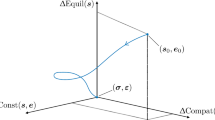Abstract
For composite materials, two quantities that are useful for characterizing the contribution of inhomogeneities in a matrix material to the overall properties are (1) the individual H-tensor, H i , which describes the contribution of a single inhomogeneity and (2) the overall strain concentration tensor, which describes the relationship between the overall volumetric strain to the average strain of all of the inhomogeneities. In this paper, we develop a relationship expressing the overall H-tensor, \({\mathcal{H}}\) , in terms of the overall strain concentration tensor. An important feature of the derivation is that it allows for rigorous upper and lower bounds on the overall H-tensor. In the special case that the inhomogeneities are all the same, with the same orientation, then \({\mathcal{H} = {\bf H}_i}\) , and the results derived for \({\mathcal{H}}\) also hold for H i .
Similar content being viewed by others
References
Ghosh, S. (2011). Micromechanical Analysis and Multi-Scale Modeling Using the Voronoi Cell Finite Element Method. CRC Press/Taylor & Francis.
Ghosh S., Dimiduk D. (2011) Computational Methods for Microstructure-Property Relations. Springer, NY
Hashin Z., Shtrikman S. (1962) On some variational principles in anisotropic and nonhomogeneous elasticity. Journal of the Mechanics and Physics of Solids. 10: 335–342
Hashin Z., Shtrikman S. (1963) A variational approach to the theory of the elastic behaviour of multiphase materials. Journal of the Mechanics and Physics of Solids. 11: 127–140
Hashin Z. (1983) Analysis of composite materials: a survey. ASME Journal of Applied Mechanics. 50: 481–505
Huet C. (1982) Universal conditions for assimilation of a heterogeneous material to an effective medium. Mechanics Research Communications. 9((3): 165–170
Huet C. (1984) On the definition and experimental determination of effective constitutive equations for heterogeneous materials. Mechanics Research Communications. 11(3): 195–200
Jikov, V. V., Kozlov, S. M., Olenik, O. A.(1994) Homogenization of differential operators and integral functionals. Springer-Verlag.
Kachanov, M. (1993) Elastic solids with many cracks and related problems. Advance Applied Mechanics, vol. 30. Academic Press, New York, p. 259.
Kachanov M., Tsukrov I., Shafiro B. (1994) Effective moduli of solids with cavities of various shapes. Appl. Mech. Rev. 47: S151–S174
Kachanov M., Sevostianov I. (2005) On the quantitative characterization of microstructures and effective properties. International Journal of Solids and Structures. 42: 309–336
Markov K.Z. (2000) Elementary micromechanics of heterogeneous media. In: Markov K.Z., Preziozi L. (eds) Heterogeneous Media: Micromechanics Modeling Methods and Simulations. Birkhauser, Boston, p 1162
Maxwell J.C. (1867) On the dynamical theory of gases. Philos. Trans. Soc. London. 157: 49
Maxwell J.C. (1873) A treatise on electricity and magnetism. 3rd. Ed. Clarendon Press, Oxford
Mura, T. (1993) Micromechanics of defects in solids, 2nd edition. Kluwer Academic Publishers.
Nemat-Nasser S., Hori M. (1999) Micromechanics: overall properties of heterogeneous solids. 2nd edition. Elsevier, Amsterdam
Rayleigh J.W. (1892) On the influence of obstacles arranged in rectangular order upon properties of a medium. Phil. Mag. 32: 481–491
Sevostianov I, Kachanov M., Zohdi T.I. (2008) On computation of the compliance and stiffness contribution tensors of inhomogeneities of non-ellipsoidal shapes. International Journal of Solids and Structures. 45(16): 4375–4383
Sevostianov, I and Kachanov, M. (2008) Connections between Elastic and Conductive Properties of Heterogeneous Materials. Advances in Applied Mechanics. Volume 42, 69–253.
Torquato S. (2002) Random Heterogeneous Materials: Microstructure and Macroscopic Properties. Springer-Verlag, New York
Zohdi, T. I. and Wriggers, P. (2008). Introduction to computational micromechanics. Springer-Verlag.
Author information
Authors and Affiliations
Corresponding author
Rights and permissions
About this article
Cite this article
Zohdi, T.I. On the Relationship Between the H-Tensor and the Concentration Tensor and Their Bounds. Int J Fract 177, 89–95 (2012). https://doi.org/10.1007/s10704-012-9749-4
Published:
Issue Date:
DOI: https://doi.org/10.1007/s10704-012-9749-4




